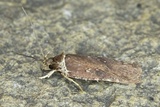Agonopterix cnicella (Treitschke, 1832) Species
Last modified: Nov. 28, 2024, 2:28 p.m.
A very rare and local species in Belgium.
Details
- Classification
- Family: Depressariidae > Subfamily: Depressariinae > Genus: Agonopterix > Species: Agonopterix cnicella
- Vernacular names
- Kruisdistelkaartmot (NL)
- First mention in Belgium
- Fologne E. 1864. Lépidoptères nouveaux pour la faune belge observés par E. Fologne. — Annales de la Société Entomologique de Belgique 8: 273–276. On page 274. view page
- Status
-
Native
Distribution
Bionomics
The larvae feed gregariously among the shoots and in rolled leaves, turning these brown.
Pupation in the sand at the base of the food
plants.
Adults are rarely observed.
No pictures yet!
Flight periods
One generation a year June–July.
Observed on
- Host plant (species):
- Eryngium maritimum and Eryngium campestre
The larva feeds mainly on Eryngium maritinum, but also on Eryngium campestre.
No pictures yet!
Habitat
Coastal dunes and floodplains along the major rivers.
No pictures yet!






